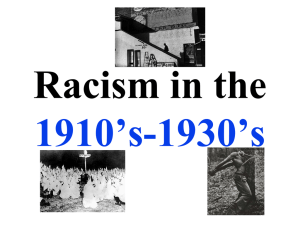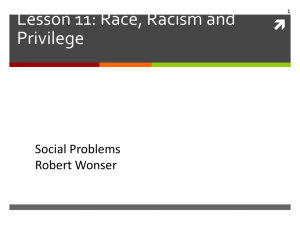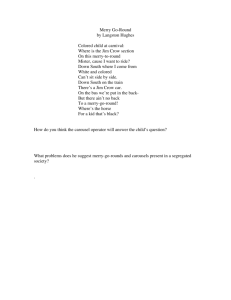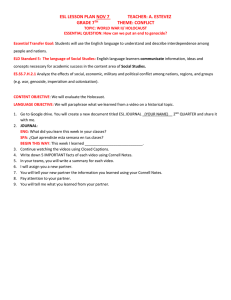The Main Dish
advertisement
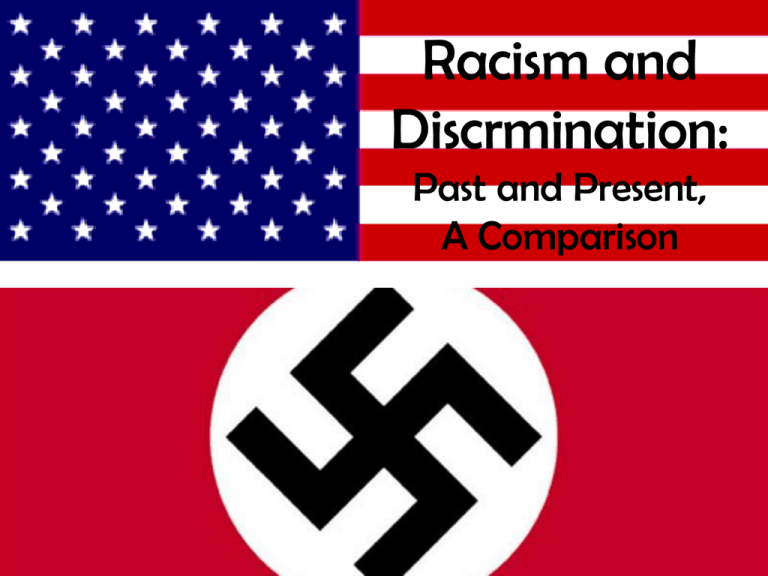
Racism and Discrmination: Past and Present, A Comparison What is Racism? Racism, by its simplest definition is the belief that race is the primary determinant of human traits and capacities and that racial differences produce an inherent superiority of a particular race. People with racist beliefs may resent certain groups of people according to their race. In the case of institutional racism, certain racial groups may be denied rights or benefits, or get preferential treatment. http://en.wikipedia.org/wiki/Racism What is Discrimination? Discrimination toward or against a person or group is the treatment or consideration based on class or category rather than individual merit. It is usually associated with prejudice. It can be behavior promoting a certain group, or it can be negative behavior directed against a certain group. The latter is the more common meaning http://en.wikipedia.org/wiki/Discrimination 1896 – Plessy v. Ferguson Facts of the Case The state of Louisiana enacted a law that required separate railway cars for blacks and whites. In 1892, Homer Adolph Plessy--who was seven-eighths Caucasian--took a seat in a "whites only" car of a Louisiana train. He refused to move to the car reserved for blacks and was arrested. Outcome The state law is within constitutional boundaries. The majority, in an opinion authored by Justice Henry Billings Brown, upheld stateimposed racial segregation. The justices based their decision on the separate-but-equal doctrine, that separate facilities for blacks and whites satisfied the Fourteenth Amendment so long as they were equal. Basically, segregation preactices was legalized. http://www.oyez.org/cases/1851-1900/1895/1895_210/ Jim Crow Laws The Jim Crow laws were state and local laws in the United States enacted between 1876 and 1965. Some examples of Jim Crow laws are the segregation of public schools, public places and public transportation, and the segregation of restrooms and restaurants for whites and blacks. The U.S. military was also segregated. http://en.wikipedia.org/wiki/Jim_Crow_laws http://www.jimcrowhistory.org/ Jim Crow Laws americanhistory.si.edu www.eurekacityschools.org Jim Crow Laws Executive Order 9066 Issued by President Franklin Roosevelt on February 19, 1942, this order authorized the evacuation of all persons deemed a threat to national security from the West Coast to relocation centers further inland. Affected Japanese-American citizens Supreme Court ruled in favor of order in Korematsu v. United States www.ourdocuments.gov Executive Order 9066 www.ourdocuments.gov ocw.mit.edu Nazi Germany Adolf Hitler was the leader of the German Nazi party and, from 1933 until his death, dictator of Germany. His rule resulted in the destruction of the German nationstate and its society, in the ruin of much of Europe's traditional structure, and in the extermination of about 6 million Jews and another few million “undesireables”. He was eventually defeated, but his temporary success demonstrated frighteningly, at the brink of the atomic age, the vulnerability of civilization. http://www.grolier.com/wwii/wwii_hitler.html www.holocaust-history.org Nuremberg Race Laws The Nuremberg Laws (1935), geschichtslk.blogspot.com defined anyone who had three or four Jewish grandparents as a Jew, regardless of whether that individual identified himself or herself as a Jew or not. Jews were required to carry identity cards, but the government added special identifying marks to theirs: a red "J" stamped on them. Jews were excluded from schools, government service, teaching and even medical service. Eventually, they even had all of their rights including citizenship taken from them. http://www.ushmm.org Holocaust The Holocaust was the systematic, bureaucratic, statesponsored persecution and murder of approximately six million Jews by the Nazi regime and its collaborators. "Holocaust" is a word of Greek origin meaning "sacrifice by fire." The Nazis, who came to power in Germany in January 1933, believed that Germans were "racially superior" and that the Jews, deemed "inferior," were an alien threat to the so-called German racial community. http://www.bgcs.k12.oh.us http://www.ushmm.org Holocaust Genocide The term "genocide" did not exist www.genocide.change.org before 1944. It is a very specific term, referring to violent crimes committed against groups with the intent to destroy the existence of the group. Human rights, as laid out in the U.S. Bill of Rights or the 1948 United Nations Universal Declaration of Human Rights, concern the rights of individuals. Genocide is the deliberate and systematic destruction, in whole or in part, of an ethnic, racial, religious, or national group. http://www.ushmm.org Darfur, Sudan In Southern Sudan, serious human rights abuses by the government and Peace Keeping troops were reported during 2008, including killings and physical abuse; poor prisons and detention centers; arbitrary arrests; use of child soldiers; abduction rape of women and children; and child labor. In Darfur government-aligned militias killed and injured civilians, including during attacks on villages; raped women and children; destroyed and looted civilian property; and used child soldiers. http://www.state.gov http://www.unmis.org Conclusions The United States never participated in or practiced genocide though racism and discrimination were. Genocide is still practiced by various governments and peoples around the world. Since WWII incidents of genocide have occurred in: Cambodia Bosnia Rwanda Sudan Currently, many world governments and organizations and humintarian agencies are addressing the issue but the practice continues with the loss of thousands of lives yearly.
